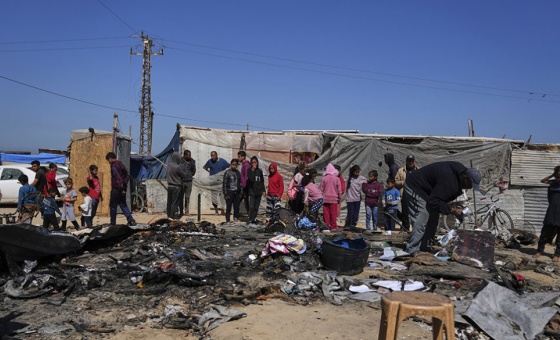This is the last article you can read this month
You can read more article this month
You can read more articles this month
Sorry your limit is up for this month
Reset on:
Please help support the Morning Star by subscribing here
PALESTINIANS in Gaza are confronting an apocalyptic landscape of devastation after a ceasefire paused more than 15 months of Israeli destruction.
Across the tiny coastal enclave, where built-up refugee camps are interspersed between cities, drone footage shows mounds of rubble stretching as far as the horizon.
“As you can see, it became a ghost town,” said Hussein Barakat, 38, whose home in the southern city of Rafah was flattened.
“There is nothing,” he said, as he sat drinking coffee on a brown armchair perched on the rubble of his three-storey home, in a surreal scene.
International human rights groups say that Israel has waged a campaign of scorched earth to destroy the fabric of life in Gaza, accusations that are being considered in two global courts, including the crime of genocide.
Israel denies those charges and says its military has been fighting a complex battle in dense urban areas, and claims that it tries to avoid causing undue harm to civilians and their infrastructure. The 47,000 people, including children, killed by Israel’s bombardment suggests otherwise.
Amnesty International, Human Rights Watch and others view the vast destruction as part of a broader pattern of extermination and genocide directed at Palestinians in Gaza. The groups dispute Israel’s stance that the destruction was a result of military activity.
Human Rights Watch, in a November report accusing Israel of crimes against humanity, said “the destruction is so substantial that it indicates the intention to permanently displace many people.”
From a fierce air campaign during the first weeks of the onslaught, to a ground invasion that sent thousands of troops in on tanks, the Israeli response to a Hamas-led attack on October 7 2023 has levelled much of the civilian infrastructure of the Gaza Strip, displacing 90 per cent of its population.
The brilliant colour of pre-war life has faded into a monotone cement grey that dominates the territory. It could take decades, if not more, to rebuild.
In Jabaliya, Nizar Hussein hung a sheet over the shattered remains of his family’s home, stepping gingerly around a large, leaning concrete slab.
“At the very least, we need years to get a house,” he said.
“It is a feeling that I cannot describe. Thank God [for everything].”
A UN assessment from satellite imagery showed more than 60,000 structures across Gaza had been destroyed and more than 20,000 severely damaged in the war as of December 1 2024.
The preliminary assessment of conflict-generated debris, including of buildings and roads, was over 50 million tons. It said the analysis had not yet been validated in the field.







